|
Historical Information

 Point Lookout juts
from the shore on the western shore of Lake Huron, approximately
half-way between the mouth of the Saginaw River and Tawas Point. With
only five to eighteen feet above it, Gravelly Shoal extends some 3 miles
southeasterly from Point Lookout towards Big Charity Island. To help
guide down-bound vessels headed for Saginaw Bay through the deeper water
lying between the southeast end of Gravelly Shoal and Big Charity
Island, Congress appropriated $5,000 to construct a lighthouse on the
northwestern shore of Big Charity on August 18, 1856. Work began at the
site that year, but as a result of being started so late in the season,
the station was not completed and lighted until the following year.
Point Lookout juts
from the shore on the western shore of Lake Huron, approximately
half-way between the mouth of the Saginaw River and Tawas Point. With
only five to eighteen feet above it, Gravelly Shoal extends some 3 miles
southeasterly from Point Lookout towards Big Charity Island. To help
guide down-bound vessels headed for Saginaw Bay through the deeper water
lying between the southeast end of Gravelly Shoal and Big Charity
Island, Congress appropriated $5,000 to construct a lighthouse on the
northwestern shore of Big Charity on August 18, 1856. Work began at the
site that year, but as a result of being started so late in the season,
the station was not completed and lighted until the following year.
Perhaps as a result of its exposed
location, or as a result of its keeper's dwelling being one of the few
of wooden frame construction on any of the Great Lakes, the station was
a constant source of maintenance problems, and was not surprisingly one
of the first to be automated through the installation of an acetylene
illumination system in 1900. At this time an occulting white Pintsch gas
buoy was also placed at the southeastern end of Gravelly Shoal to better
mark the western edge of the passage between the shoal and Big Charity
Island.
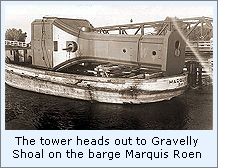 As a result of the combination of
increasing vessel size, improvements in offshore light construction and
the growing adoption of radio direction finding equipment, it became
plain in the late 1930's that the old Charity light and the gas buoy on
Gravelly Shoal had outlived their usefulness, and consideration turned
to the construction of a state-of-the-art offshore aid to navigation at
the eastern end of Gravelly Shoal to better mark the deeper water of the
passage. United States Lighthouse Service engineers F. P. Dillon and W.
G. Will were tasked with the design of the structure, and resurrected
their design previously used with great success on Lake Erie at both
Conneaut and Huron in 1935. As a result of the combination of
increasing vessel size, improvements in offshore light construction and
the growing adoption of radio direction finding equipment, it became
plain in the late 1930's that the old Charity light and the gas buoy on
Gravelly Shoal had outlived their usefulness, and consideration turned
to the construction of a state-of-the-art offshore aid to navigation at
the eastern end of Gravelly Shoal to better mark the deeper water of the
passage. United States Lighthouse Service engineers F. P. Dillon and W.
G. Will were tasked with the design of the structure, and resurrected
their design previously used with great success on Lake Erie at both
Conneaut and Huron in 1935.
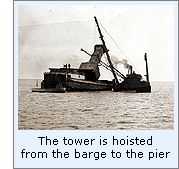 As
a sign of the times, construction of the new light on Gravelly Shoal was
incorporated as part of President Franklin Delano Roosevelt's Public
Works Administration, designed to "put America back to work,"
and as such was built under PWA project No. 56. Bids for the actual
construction work were advertised out of the Detroit depot, with
32-year-old John C. Meagher of Bay City's bid of $75,000 winning him the
contract. The $24,000 contract for the fabrication of the steel tower itself was awarded to
the Wickes Boiler Company, the world-renowned boiler engineering and
fabricator, located in Saginaw. As
a sign of the times, construction of the new light on Gravelly Shoal was
incorporated as part of President Franklin Delano Roosevelt's Public
Works Administration, designed to "put America back to work,"
and as such was built under PWA project No. 56. Bids for the actual
construction work were advertised out of the Detroit depot, with
32-year-old John C. Meagher of Bay City's bid of $75,000 winning him the
contract. The $24,000 contract for the fabrication of the steel tower itself was awarded to
the Wickes Boiler Company, the world-renowned boiler engineering and
fabricator, located in Saginaw.
 Meagher's flotilla, consisting of the
crew boat Tipperary and the old wooden work barge Marquis
Roen, set out for Gravelly Shoal on a calm April 12th, 1939, and
after using a sextant to locate the specified location for the light
(44°03.0'N., 83°32.3'W.), turned to the task of driving five
wire-wrapped pile clusters deep into the bottom in 24 ½ feet of water.
After the installation of waterproof exterior forms and the removal of
the water with pumps, the concrete 50-foot diameter pier itself was
poured, along with its integral basement service rooms. Meagher's flotilla, consisting of the
crew boat Tipperary and the old wooden work barge Marquis
Roen, set out for Gravelly Shoal on a calm April 12th, 1939, and
after using a sextant to locate the specified location for the light
(44°03.0'N., 83°32.3'W.), turned to the task of driving five
wire-wrapped pile clusters deep into the bottom in 24 ½ feet of water.
After the installation of waterproof exterior forms and the removal of
the water with pumps, the concrete 50-foot diameter pier itself was
poured, along with its integral basement service rooms.
 Conditions
at the site continued atypically calm through April and May, with only
two days lost due to inclement weather conditions. However, things took
a turn for the worse in July, when the water became so rough that in one
thirty day stretch the crew was only able to tie-up at the pier on one
single occasion. By August, conditions began to clear, and with work on
the pier complete, the Marquis Roen arrived at the Wickes Boiler
Company dock, and the 61-foot tall steel tower was hoisted onto the
barge's deck for the trip out to the shoal. Tied-up alongside the
circular pier, a large wooden shear leg was erected on the
barge's deck, and the 25-ton tower carefully lifted from the deck and
lowered inch-by-inch onto its locating bolts at the center of the
concrete pier. Conditions
at the site continued atypically calm through April and May, with only
two days lost due to inclement weather conditions. However, things took
a turn for the worse in July, when the water became so rough that in one
thirty day stretch the crew was only able to tie-up at the pier on one
single occasion. By August, conditions began to clear, and with work on
the pier complete, the Marquis Roen arrived at the Wickes Boiler
Company dock, and the 61-foot tall steel tower was hoisted onto the
barge's deck for the trip out to the shoal. Tied-up alongside the
circular pier, a large wooden shear leg was erected on the
barge's deck, and the 25-ton tower carefully lifted from the deck and
lowered inch-by-inch onto its locating bolts at the center of the
concrete pier.
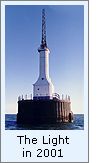 As
the project neared completion, Meagher speculated that the thickness of
the pier at the waterline was insufficient to withstand Huron's heavy
wither ice crush. Convinced of his calculations, he recommended the
thickness of the pier at the side walls be increased by seven feet to
better protect the piers structural integrity, and provided a quotation
of $7,000 to perform the additional work. However, the Coast Guard, to
whom responsibility for the nation's aids to navigation had been
transferred that same year, disagreed, and accepted the station as
constructed, placing it into service in October, 1939. As
the project neared completion, Meagher speculated that the thickness of
the pier at the waterline was insufficient to withstand Huron's heavy
wither ice crush. Convinced of his calculations, he recommended the
thickness of the pier at the side walls be increased by seven feet to
better protect the piers structural integrity, and provided a quotation
of $7,000 to perform the additional work. However, the Coast Guard, to
whom responsibility for the nation's aids to navigation had been
transferred that same year, disagreed, and accepted the station as
constructed, placing it into service in October, 1939.
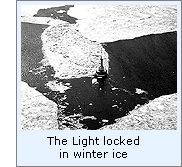 Designed
as a completely automated electrified station, the Gravelly Shoal Light
came under the control and maintenance of Coast Guard Station Tawas. The
station's 375 mm light was equipped with a 15,000 candlepower, 120 volt
electric lamp with current supplied by way of a submarine cable laid
across the surface of the shoal from Point Lookout. The light's 75-foot
focal plane allowed the characteristic 1-second flash every 5 seconds to
be seen from a distance of 16 miles. A standby 110 candlepower acetylene
light with a half second flash every three seconds was also installed,
and was designed to activate automatically whenever electrical power at
the station was lost For operation in thick weather, the station was
also equipped with twin two-tone #3 diaphones, emitting a characteristic
30-second cycle consisting of a 3-second blast followed by 27 seconds of
silence. The diaphones received their supply of compressed air from twin
electrically driven compressors located in the utility rooms deep within
the pier. Designed
as a completely automated electrified station, the Gravelly Shoal Light
came under the control and maintenance of Coast Guard Station Tawas. The
station's 375 mm light was equipped with a 15,000 candlepower, 120 volt
electric lamp with current supplied by way of a submarine cable laid
across the surface of the shoal from Point Lookout. The light's 75-foot
focal plane allowed the characteristic 1-second flash every 5 seconds to
be seen from a distance of 16 miles. A standby 110 candlepower acetylene
light with a half second flash every three seconds was also installed,
and was designed to activate automatically whenever electrical power at
the station was lost For operation in thick weather, the station was
also equipped with twin two-tone #3 diaphones, emitting a characteristic
30-second cycle consisting of a 3-second blast followed by 27 seconds of
silence. The diaphones received their supply of compressed air from twin
electrically driven compressors located in the utility rooms deep within
the pier.
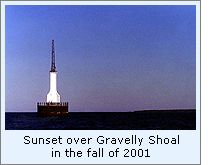 Fifteen
years after the station's completion, the Coast Guard determined that
winter ice floes were placing undue stress on the pier side walls, and
as the original contractor, Meagher was approached to add seven feet of concrete to strengthen the pier sides. Meagher was more than happy to
make the modification at a cost of $54,000, some $47,000 more than the
amount he had quoted fifteen years previously! Fifteen
years after the station's completion, the Coast Guard determined that
winter ice floes were placing undue stress on the pier side walls, and
as the original contractor, Meagher was approached to add seven feet of concrete to strengthen the pier sides. Meagher was more than happy to
make the modification at a cost of $54,000, some $47,000 more than the
amount he had quoted fifteen years previously!
At some thereafter, a large steel tower
was erected atop the station for a radiobeacon transmitter. The 1953
Coast Guard Light List indicating that the signal transmitted at 296
kilocycles, and emitted a group of 0.5 -second dashes for 15.5 seconds,
followed by 14.5 seconds of silence. As of 2001, both the light and
radiobeacon still serve as active aids to navigation.

Seeing this light

We have yet to visit this light, however thanks to
the Meagher family sharing John Meagher's photographs, and specially to
Suzanne Meagher David for having the foresight to record John Meagher's
recollections of building Gravelly Shoal Light.

Finding this
Light

We have yet to determine the best way to get out to view this light.

Reference
Sources
 Lake Pilot's Handbook,
Captain George Trimble, 1907 Lake Pilot's Handbook,
Captain George Trimble, 1907
Great Lakes Light List, US Coast Guard, 1953
Oral history of John C. Meagher,
as told to Suzanne Meagher David, Nov 1987.
John Meagher's photographs courtesy of the Peter Meagher family
collection.
Lighthouses still shine beacons, Bay City Times, Nov 30, 1987.
Coast Pilot 6, The Great Lakes,
NOAA, 2000
09/01/01 email from Jeff Laser on USLHS engineers responsible for tower
design.
USCG Historian's Office -
photographic archives.
|
 Point Lookout juts
from the shore on the western shore of Lake Huron, approximately
half-way between the mouth of the Saginaw River and Tawas Point. With
only five to eighteen feet above it, Gravelly Shoal extends some 3 miles
southeasterly from Point Lookout towards Big Charity Island. To help
guide down-bound vessels headed for Saginaw Bay through the deeper water
lying between the southeast end of Gravelly Shoal and Big Charity
Island, Congress appropriated $5,000 to construct a lighthouse on the
northwestern shore of Big Charity on August 18, 1856. Work began at the
site that year, but as a result of being started so late in the season,
the station was not completed and lighted until the following year.
Point Lookout juts
from the shore on the western shore of Lake Huron, approximately
half-way between the mouth of the Saginaw River and Tawas Point. With
only five to eighteen feet above it, Gravelly Shoal extends some 3 miles
southeasterly from Point Lookout towards Big Charity Island. To help
guide down-bound vessels headed for Saginaw Bay through the deeper water
lying between the southeast end of Gravelly Shoal and Big Charity
Island, Congress appropriated $5,000 to construct a lighthouse on the
northwestern shore of Big Charity on August 18, 1856. Work began at the
site that year, but as a result of being started so late in the season,
the station was not completed and lighted until the following year.
 As a result of the combination of
increasing vessel size, improvements in offshore light construction and
the growing adoption of radio direction finding equipment, it became
plain in the late 1930's that the old Charity light and the gas buoy on
Gravelly Shoal had outlived their usefulness, and consideration turned
to the construction of a state-of-the-art offshore aid to navigation at
the eastern end of Gravelly Shoal to better mark the deeper water of the
passage. United States Lighthouse Service engineers F. P. Dillon and W.
G. Will were tasked with the design of the structure, and resurrected
their design previously used with great success on Lake Erie at both
Conneaut and Huron in 1935.
As a result of the combination of
increasing vessel size, improvements in offshore light construction and
the growing adoption of radio direction finding equipment, it became
plain in the late 1930's that the old Charity light and the gas buoy on
Gravelly Shoal had outlived their usefulness, and consideration turned
to the construction of a state-of-the-art offshore aid to navigation at
the eastern end of Gravelly Shoal to better mark the deeper water of the
passage. United States Lighthouse Service engineers F. P. Dillon and W.
G. Will were tasked with the design of the structure, and resurrected
their design previously used with great success on Lake Erie at both
Conneaut and Huron in 1935.
 As
a sign of the times, construction of the new light on Gravelly Shoal was
incorporated as part of President Franklin Delano Roosevelt's Public
Works Administration, designed to "put America back to work,"
and as such was built under PWA project No. 56. Bids for the actual
construction work were advertised out of the Detroit depot, with
32-year-old John C. Meagher of Bay City's bid of $75,000 winning him the
contract. The $24,000 contract for the fabrication of the steel tower itself was awarded to
the Wickes Boiler Company, the world-renowned boiler engineering and
fabricator, located in Saginaw.
As
a sign of the times, construction of the new light on Gravelly Shoal was
incorporated as part of President Franklin Delano Roosevelt's Public
Works Administration, designed to "put America back to work,"
and as such was built under PWA project No. 56. Bids for the actual
construction work were advertised out of the Detroit depot, with
32-year-old John C. Meagher of Bay City's bid of $75,000 winning him the
contract. The $24,000 contract for the fabrication of the steel tower itself was awarded to
the Wickes Boiler Company, the world-renowned boiler engineering and
fabricator, located in Saginaw.
 Meagher's flotilla, consisting of the
crew boat Tipperary and the old wooden work barge Marquis
Roen, set out for Gravelly Shoal on a calm April 12th, 1939, and
after using a sextant to locate the specified location for the light
(44°03.0'N., 83°32.3'W.), turned to the task of driving five
wire-wrapped pile clusters deep into the bottom in 24 ½ feet of water.
After the installation of waterproof exterior forms and the removal of
the water with pumps, the concrete 50-foot diameter pier itself was
poured, along with its integral basement service rooms.
Meagher's flotilla, consisting of the
crew boat Tipperary and the old wooden work barge Marquis
Roen, set out for Gravelly Shoal on a calm April 12th, 1939, and
after using a sextant to locate the specified location for the light
(44°03.0'N., 83°32.3'W.), turned to the task of driving five
wire-wrapped pile clusters deep into the bottom in 24 ½ feet of water.
After the installation of waterproof exterior forms and the removal of
the water with pumps, the concrete 50-foot diameter pier itself was
poured, along with its integral basement service rooms.
 Conditions
at the site continued atypically calm through April and May, with only
two days lost due to inclement weather conditions. However, things took
a turn for the worse in July, when the water became so rough that in one
thirty day stretch the crew was only able to tie-up at the pier on one
single occasion. By August, conditions began to clear, and with work on
the pier complete, the Marquis Roen arrived at the Wickes Boiler
Company dock, and the 61-foot tall steel tower was hoisted onto the
barge's deck for the trip out to the shoal. Tied-up alongside the
circular pier, a large wooden shear leg was erected on the
barge's deck, and the 25-ton tower carefully lifted from the deck and
lowered inch-by-inch onto its locating bolts at the center of the
concrete pier.
Conditions
at the site continued atypically calm through April and May, with only
two days lost due to inclement weather conditions. However, things took
a turn for the worse in July, when the water became so rough that in one
thirty day stretch the crew was only able to tie-up at the pier on one
single occasion. By August, conditions began to clear, and with work on
the pier complete, the Marquis Roen arrived at the Wickes Boiler
Company dock, and the 61-foot tall steel tower was hoisted onto the
barge's deck for the trip out to the shoal. Tied-up alongside the
circular pier, a large wooden shear leg was erected on the
barge's deck, and the 25-ton tower carefully lifted from the deck and
lowered inch-by-inch onto its locating bolts at the center of the
concrete pier.
 As
the project neared completion, Meagher speculated that the thickness of
the pier at the waterline was insufficient to withstand Huron's heavy
wither ice crush. Convinced of his calculations, he recommended the
thickness of the pier at the side walls be increased by seven feet to
better protect the piers structural integrity, and provided a quotation
of $7,000 to perform the additional work. However, the Coast Guard, to
whom responsibility for the nation's aids to navigation had been
transferred that same year, disagreed, and accepted the station as
constructed, placing it into service in October, 1939.
As
the project neared completion, Meagher speculated that the thickness of
the pier at the waterline was insufficient to withstand Huron's heavy
wither ice crush. Convinced of his calculations, he recommended the
thickness of the pier at the side walls be increased by seven feet to
better protect the piers structural integrity, and provided a quotation
of $7,000 to perform the additional work. However, the Coast Guard, to
whom responsibility for the nation's aids to navigation had been
transferred that same year, disagreed, and accepted the station as
constructed, placing it into service in October, 1939.
 Designed
as a completely automated electrified station, the Gravelly Shoal Light
came under the control and maintenance of Coast Guard Station Tawas. The
station's 375 mm light was equipped with a 15,000 candlepower, 120 volt
electric lamp with current supplied by way of a submarine cable laid
across the surface of the shoal from Point Lookout. The light's 75-foot
focal plane allowed the characteristic 1-second flash every 5 seconds to
be seen from a distance of 16 miles. A standby 110 candlepower acetylene
light with a half second flash every three seconds was also installed,
and was designed to activate automatically whenever electrical power at
the station was lost For operation in thick weather, the station was
also equipped with twin two-tone #3 diaphones, emitting a characteristic
30-second cycle consisting of a 3-second blast followed by 27 seconds of
silence. The diaphones received their supply of compressed air from twin
electrically driven compressors located in the utility rooms deep within
the pier.
Designed
as a completely automated electrified station, the Gravelly Shoal Light
came under the control and maintenance of Coast Guard Station Tawas. The
station's 375 mm light was equipped with a 15,000 candlepower, 120 volt
electric lamp with current supplied by way of a submarine cable laid
across the surface of the shoal from Point Lookout. The light's 75-foot
focal plane allowed the characteristic 1-second flash every 5 seconds to
be seen from a distance of 16 miles. A standby 110 candlepower acetylene
light with a half second flash every three seconds was also installed,
and was designed to activate automatically whenever electrical power at
the station was lost For operation in thick weather, the station was
also equipped with twin two-tone #3 diaphones, emitting a characteristic
30-second cycle consisting of a 3-second blast followed by 27 seconds of
silence. The diaphones received their supply of compressed air from twin
electrically driven compressors located in the utility rooms deep within
the pier. Fifteen
years after the station's completion, the Coast Guard determined that
winter ice floes were placing undue stress on the pier side walls, and
as the original contractor, Meagher was approached to add seven feet of concrete to strengthen the pier sides. Meagher was more than happy to
make the modification at a cost of $54,000, some $47,000 more than the
amount he had quoted fifteen years previously!
Fifteen
years after the station's completion, the Coast Guard determined that
winter ice floes were placing undue stress on the pier side walls, and
as the original contractor, Meagher was approached to add seven feet of concrete to strengthen the pier sides. Meagher was more than happy to
make the modification at a cost of $54,000, some $47,000 more than the
amount he had quoted fifteen years previously! Lake Pilot's Handbook,
Captain George Trimble, 1907
Lake Pilot's Handbook,
Captain George Trimble, 1907